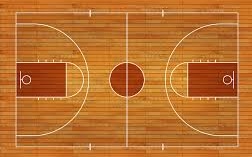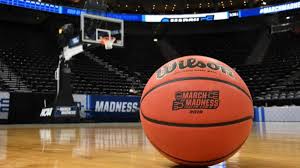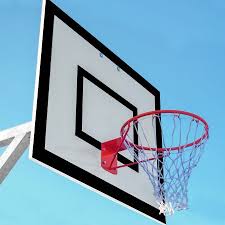
About Basketball
Basketball is a team sport played with a ball on a rectangular court comprising of hoops at either end of the court, with each hoop-shaped as a basket, hence the name Basketball.
Each team has five players and plays on the opposing ends of the court. The five players of a team, have different positions allocated to them with the tallest player in the centre.
The game is distributed, into four quarters of 10 minutes each. For NBA each quarter is of 12 minutes. So the duration of a Basketball game is 40 min with a quarter of 10 min.
A break of 15 minutes is provided, between half-time. The time mentioned is the actual playing time. The clock is stopped when the ball is not in active play, thus extending the game to more than 40 minutes.
Five members of a team should be present in the court at any given time. The players can be substituted unlimitedly but only when the play is stopped.
A limited number of time-out can be requested, by the coach for team discussions duration of which can be of one minute. There are other supporting staffs like doctors, trainers, team coach, assistant coach manager and statistician associated with a team.
A Basketball game is officiated by two referees and table officials. The table officials are responsible for timekeeping, team fouls, team scoring, team substitution and ball time. This sport is played by both Men and Women. This game is organized and governed by FIBA (Fèdèration Internationale de Basketball Amateur)
Basketball Olympic 2020 logo : 
History
Basketball dates back to 1891, James Naismith a Canadian physical education teacher, trying to maintain proper fitness level of his gym students, during the long winters, invented this game.
The hoops during that period was indeed like a basket with the bottom sealed. The player has to take out the ball from the basket for continuing the game which proved to be time-consuming and drastically reduced the speed with which the game was played. A soccer ball was used to play this sport.
Later the netting around the hoop was removed allowing, the ball to have a freefall once it entered the hoop. This resulted in frequent fights between players confronting that ball has passed through the hoop, while others denying it.
So the net without a bottom was introduced, the ball passing through the bottom net eventually shakes the net, thus confirming the ball indeed passed through the hoop.
The game eventually became popular in Canada and America, and a backboard attaching the hoop was introduced, so that the ball could rebound the board and land up in the hoop.
Around the early 1900s, these game gained immense popularity among university youth and military personals. Each university and college had their Basketball team and would often compete.
By 1950s Basketball had gained much popularity and professional games were played, between teams. With the formation of the Basketball Association of America, the game was regularized and organized.
National Basketball Association was formed, in 1949 by merging all the governing bodies, thus started the growth of professional Basketball.
FIBA (Fèdèration Internationale de Basketball Amateur), the governing body for Basketball was formed, in 1932 as an organizing and governing body of Basketball for both Men and Women. Men’s Basketball was first introduced, in the 1936 Berlin Olympics.
Objective
The objective of the game is to shoot the ball through the defender’s basket. Each basket scored has points associated with it depending upon the throwing position.
Player of the attacking team advances the ball to the teammates by bouncing the ball while running, walking or dribbling and shoots the ball passing through the defence of the defending team.
Fouls committed by a team is compensated, by providing free throws to the opponent team. The team scoring the maximum number of points after the allocated time is declared, as the winner.
If the scores at the end of the play are tied, then an additional period of play can be provided by the match officials.
Equipments
The equipment used for Basketball is the Court, Ball and metal Hoops attached to a backboard on either side of the court.
Court: The Basketball court is 28 m long and 15 m wide made of wooden or synthetic flooring.

Ball: The Basketball weighs 623.69 grams for men and 567 grams for women. Size 7 ball is used for men with a circumference of 75 cms, women use size 6 ball that has a circumference of 72 cms.

Hoop: The hoop is a metal ring attached to a backboard having a diameter of 18 inches with an attached net. The backboard measures, 1.8 meters by 1.1 meters. The hoop is exactly 10 meters above the ground and 4 feet inside the baseline of the court. Two hoops are placed, on either side of the court.

Terms Associated
Rebounding: Possession of the ball gained from a missed shot that bounces off the backboard or rim.
Shooting: An attacking player puts the ball through the hoop resulting in points.
Defending: Performed by the defending team members by preventing the attacking team members from throwing the ball in the hoop.
Dribbling: Bouncing the ball with one hand and advancing to attack, or preventing the defensive team member to grab the ball.
Catching and Passing: Throwing the ball to teammates to gain a position of advantage.
Moving without Ball: Players breaking free from the defenders and moving to an advantageous position without the ball so that the ball can be passed to them.
Jumping: Jumping is an important skill of Basketball, it involves players jumping for the ball, jumping for shooting, jumping for catching the rebound, jumping for defending the throw.
Player Position
A team may consist of 12 players, only five of the players are active in the court at any time. Though the players can move through any part of the court depending upon opportunity, they have designated positions allocated to them.
Point Guard(PG): PG always leads the team in assists and creates shots for teammates and themselves. They are the team’s best ball passer and handler. They are fast, agile and leads the team in fast attacks.
Shooting guard(SG): SG as the name suggests, they are very good at shooting the ball through the hoop over three-point range and mid-range. They are the best defenders of the team and always hover on the three-point line for taking the shot.
Small Forward(SF): SF is very fast and agile players, they possess outstanding dribbling skills. They are not great shooters, their primary work is to get away with the ball and pass it to other teammates. They are not top scorers but persists the ability to throw over the three-point line.
Power Forward (PF): PF, as the name suggests, are powerful forward players. They are the dependent scorer of the team. The ability of this player includes shooting the ball from short range. They should have the athleticism to jump and shoot, in the basket.
Center(C): C always plays close to the basket. They are the tallest player of the team and are very good at close perimeter shooting. The centre is considered to be the most important position in the team. They dominate the team with the defensive by blocking a high ball.
Fouls
Referees assess the game played by the teams and penalize a team for committing fouls. There are different types of fouls depending upon the situation and team is penalized, by awarding two free throws to the opponent team. Each player is allowed up to five fouls before they are removed, from the game.
Team Foul: Any foul charged on a team. When team fouls reach 7, the opponent team gets a bonus free throw.
Flagrant Foul: A violent foul, like kicking, kneeing or striking an opponent.
Holding Foul: This is a personal foul committed by the player that involves illegal contact with an opponent, like hindering the freedom of movement of the player.
Elbowing: When a player elbows another player of the opponent team.
Charging: This foul is imposed, when an attacking player makes a contact, with the defender already stationed at a position.
Blocking: This foul is imposed, when a defender makes a contact, with the attacking player thus impeding the progress of the attacker.
Personal Foul: This foul is imposed, on a player making illegal contact with a player of another team hindering the movement of the attacking or defensive player with or without having the ball.
Hand Check: A foul caused by the defender making continuous contact with hands to the opponent player.
Intentional Foul: This is a technical foul that opposes the position of advantage to the opponent when the player makes no legitimate attempt to play the ball to the teammates.
Violations
Violation by team member leads to loss of the possession of the ball. There are several such violations introduced to make the game fair and agile.
Double Dribble: This violation occurs when a player dribbles the ball with both the hands at the same time
Lane Violation: This violation occurs when a player enters the lane too soon in a free-throw situation.
Back Court Violation: This violation occurs when the player is the last one in the team to touch the ball before it goes to the backcourt. That player should not be the first player to touch the ball in the backcourt.
Travelling: This violation occurs when a player tries to move with the ball without proper dribbling.
Ten Seconds Violation: This violation occurs when a team fails to transfer the ball from backcourt to the frontcourt within ten seconds.
Three Seconds In Lane: This violation occurs when an attacking team player is longer than three seconds inside the free throw lane without having the ball when the team in control of the ball in the frontcourt.
The player is allowed to remain inside the free throw lane for more than three seconds if the player has the ball and trying to drive the ball towards the hoop.
Scoring
Based on the total point scored by the team at the end of the stipulated match time, winner is decided. The point strategy in Basketball is
A successful shot made from the within the three-pointer line is worth 2 points.
A successful shot made from outside the three-pointer line is worth 3 points.
Each successful shot on a free throw awarded to the team is worth 1 point.
Rules Of Basketball
- A team can only have 5 team members of a team at the court at any time of the game. Though there is no limit to substitution.
- When a team wins possession of the ball, the ball must be back over the halfway line within 10 seconds.
- The ball is returned, to the opposition after every successful basket.
- The attacking team has a period of 24 seconds to attempt a shot at the basket. The clock is restarted, if the ball hits the rim of the basket and falls out.
- Once the ball is touched by the player with both the hands, they are only allowed to pass, and not allowed to dribble or move with the ball.
- Fouls committed by the team are accumulated, and accordingly, free throws are awarded, to the opposition based on which points are earned, after a successful throw.
- Violations by team result in losing possession of the ball to the opposition, and can also award in free throws as decided by the referees.
World Rankings
- World rankings based on teams standings
- Mens Team
- Team USA

- Team Spain

- Team Australia

- Womens Team
- Team USA

- Team Australia

- Team Spain





 (1 votes, average: 5.00 out of 5)
(1 votes, average: 5.00 out of 5)


